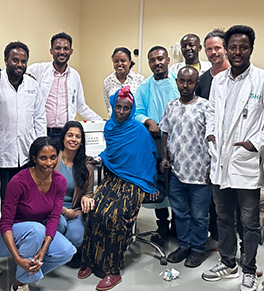
Ovarian cancer
Comprehensive ovarian cancer care — expert treatment, advanced technology and support to guide you every step of the way.
At UCI Health, physicians and staff who’ve undergone extensive training in the treatment of ovarian cancer will care for you.
Signs and symptoms of ovarian cancer
Early detection and diagnosis provide a woman’s best chance to combat ovarian cancer.
Some common ovarian cancer symptoms include:
- Pressure or fullness in the pelvis
- Abdominal bloating
- Rapid weight gain
- Changes in bowel and bladder patterns that continue or worsen over a period of weeks or months
Early-stage ovarian cancer often has no symptoms or vague, non-specific symptoms. If you have a family history, it’s important to get evaluated regularly.

Take the next step
Take the next step in your ovarian cancer care by scheduling a consultation with our expert team. We're here to provide personalized treatment options and support every step of the way.
Call 714-456-8000 to make an appointment with one of our expert gynecological oncologists.

Find a cancer clinical trial
Talk to your doctor to see if a cancer clinical trial is right for you.

Yoo Schneider, UCI Health patient and ovarian cancer survivor
“I cry every time I talk about my story because I know I wouldn’t be here today if it wasn’t for Dr. Bristow.”
Featured Blog Posts

Medical mission brings advanced radiation therapy to fight cervical cancer in Ethiopia
UCI Health radiation oncologist Dr. Priya Mitra trained local medical staff in the lifesaving treatment.

HPV-related oral cancers soar among men

A 'dream come true' realized in Irvine
Dr. Michael J. Stamos once envisioned opening a small cancer center on the UC Irvine campus. What has emerged, he says, is so much more.
Ovarian cancer diagnosis at UCI Health
Symptoms like abdominal bloating, weight gain or changes in bowel or urinary habits could be signs of ovarian cancer. Your doctor might also find a mass during a routine pelvic exam.
Ovarian cancer treatment at UCI Health
Treating the whole you
You are much more than your diagnosis. When we care for you, we consider every aspect of your life, including menopause, bone and sexual health, memory and fatigue.
We offer advanced, compassionate care, combining leading-edge treatments with personalized support.
Our physicians — gynecologic oncologists, surgeons, oncologists, radiologists and pathologists — work together to provide each woman with comprehensive and individualized care.
Managing recurrence
Many women with ovarian cancer may experience a recurrence, which we monitor closely through regular blood tests, check-ups and scans.
If the cancer comes back, your doctor will tailor the treatment to your situation, often starting with scans to see where the cancer has spread. About 40% of women might be able to have surgery to remove the cancer again, especially if it’s in just a few spots and you’re healthy enough for the procedure.
Treatment options like chemotherapy or, in some cases, radiation, will depend on your past treatments and how your body responded.
Why choose UCI Health for ovarian cancer care
NCI designated
UCI Health is home to the Chao Family Comprehensive Cancer Center, the only National Cancer Institute-designated cancer center in Orange County.
That means you have access to the latest treatments, experienced specialists and innovative research. You’ll experience the best care, personalized based on your specific diagnosis.
University affiliated
We’re the only academic health system in Orange County. As a teaching hospital, we combine expert care with innovation, offering you personalized treatment options and the opportunity to be part of groundbreaking clinical trials.
Innovative treatments
We were among the first in the region to offer hyperthermic intraperitoneal chemotherapy or HIPEC, a unique treatment designed to kill ovarian cancer cells left behind after surgery.
Ann’s Clinic
We are home to Ann’s Clinic, the only program of its kind in Orange County. It’s dedicated exclusively to the screening and care of women at high risk of developing ovarian, breast and other gynecologic cancers.
Ann’s Clinic is offered in collaboration with the Queen of Hearts Foundation, a Newport Beach-based nonprofit organization dedicated to the prevention and early detection of ovarian cancer.
The Clinic addresses the special needs of women with ovarian cancer, provides community support and promotes clinical research.
Our genetic counselor assesses individual risk to help physician specialists develop your personalized care plan.
Ann’s Clinic is named after Ann Dobbie, the late mother of the founders. She was diagnosed with an aggressive form of ovarian cancer in summer 1999 and died shortly after.




